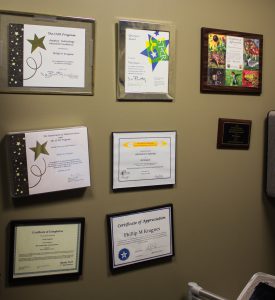Philip Kragnes is dedicated to making technology work for everyone, especially those with disabilities.
As manager of the computer accommodations program at the University of Minnesota, Kragnes has led the effort to open up technology to all students by creating guidelines, training tools and policy to make the university’s software not only legally accessible but also diverse and welcoming.
He also knows a bit about needing those tools. Kragnes lost his vision due to diabetes when he was a senior in high school. He is also a double amputee below the knee, a circumstance he finds humor in by wearing shorts on the coldest of Minnesota days.
His prosthetics and his impaired vision have never been obstacles for Kragnes. He has climbed the three highest peaks in New Mexico, whitewater canoed and took up powerlifting. He credits his loss of vision with helping him develop his typing skill and learning how to navigate without visual cues.
“If I can inspire others to say, ‘Wow, if he can do it, so can I,’ or, ‘I’m going to need to work on that again,’ that’s all that matters,” he said. “Everyone has to learn that it doesn’t matter how you get it done. Life is about learning how to get it done in a way that works for you.”
Kragnes has his degree in cognitive psychology, which is the study of human memory, learning, cognition and information processing, and he taught himself to code on his own. Combine those with his knowledge and interest in technology, teaching and training, and, as he says, his job through the Disability Resource Center is a “perfect fit.”
When Kragnes began working at the University of Minnesota in 1998, there were no real standards the university had for accommodative technology, so he created a list of guidelines for accessible web design. He also developed the WARCD (Web Accessibility Resource CD), a training tool to improve and enlarge the accessibility program that he passionately felt needed greater attention. In 2001, he proposed and wrote a policy on the accessibility of information technology, which since then has been revised and edited—by himself, of course.
“No one sets out to create an inaccessible website,” Kragnes said. “There is a lack of awareness, a lot of myths, and learning about it takes time. However, once you understand implementing it, it doesn’t take much more time.”

In a collaborative effort with his supervisors and colleagues, he created the Accessible U website, which launched in 2005. The website provides various tools for understanding how accommodations should be made to increase accessibility for digital materials. Afterward, Kragnes created a second website called “Inclusive By Design,” which offers a more technical approach.
“The accessible site is trying to reach as many people as possible from all different levels,” Kragnes said. “My website starts at a more mid-level range to help programmers with web accessible coding techniques and features.”
In line with his passion for teaching programmers to be more mindful of accessibility, Kragnes actively participates in bringing accessibility to the classrooms as well. In a collaborative effort with Joseph Konstan, a professor in the Department of Computer Science and Engineering, they created a set of video lectures for an online course in user interface design.
“I first met with him when we were discussing the idea of creating more course content in some form of dealing with accessible design,” Konstan said. “He’s taught me a huge amount about the different things you can do once you’re aware of the types of limitations you’re designing for.”
Gordon Legge, a psychology professor at the university and Kragnes’ friend of 18 years, describes Kragnes as an expert and a valuable resource for the university and himself.
Every other year, Legge teaches a class called Perceptual Issues in Visual Impairments and invites Kragnes to be a guest lecturer. “Philip [teaches] a class and gives students a tour through adaptive technology for visually impaired people,” Legge said. “It’s one of my most popular classes.”
 Despite his walls filled with awards from various institutions, organizations and government, Kragnes remains humble: He jokes that they don’t matter to him since he can’t see them anyway. He does recall a time before the loss of his vision when he saw a room of his cousin’s trophies and wanted to pursue something that would earn him such accolades. But he knows what you do is worth more than any recognition that could come from it.
Despite his walls filled with awards from various institutions, organizations and government, Kragnes remains humble: He jokes that they don’t matter to him since he can’t see them anyway. He does recall a time before the loss of his vision when he saw a room of his cousin’s trophies and wanted to pursue something that would earn him such accolades. But he knows what you do is worth more than any recognition that could come from it.
When asked about the award he received from the state of Minnesota, presented to him in person by the lieutenant governor, Kragnes said: “I’m sure it’s up on the wall somewhere, but I can’t remember.”
“Any award that I’ve received is simply telling me that I’m doing the right thing,” Kragnes said. “Whether it be employment, academics, society, creating laws, guidelines or policies, it’s letting me know that I’m making my corner of the world a little bit more involved, a little bit better.”

